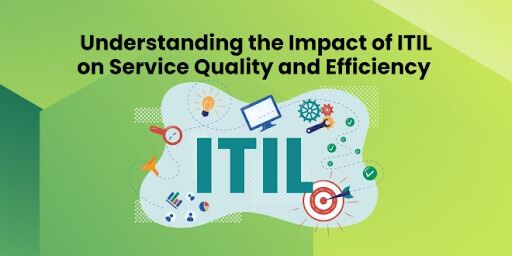It’s no secret that the Information Technology Infrastructure Library, or ITIL, has played a crucial role in helping organizations achieve this goal. If you’re unfamiliar with ITIL and its impact on service quality and efficiency, you’ve come to the right place. We will explore the world of ITIL and delve into its profound influence on improving service quality and operational efficiency. Also, we’ll explore What is ITIL in this blog.
Table of Contents
- What is ITIL?
- Impact of ITIL on Service Quality
- Impact of ITIL on Operational Efficiency
- Conclusion
What is ITIL?
The Information Technology Infrastructure Library (ITIL) is a collection of practices and frameworks developed to assist organisations in managing and optimising their IT services. ITIL, which was developed in the 1980s by the UK government, has grown over time to become the worldwide standard for IT service management (ITSM). ITIL, at its core, offers a standardised way to plan, provide, and monitor IT services in order to efficiently fulfil business objectives.
Impact of ITIL on Service Quality
The increase in service quality is one of the most important effects of ITIL on organisations. This is how ITIL adds to this critical aspect:
1. Customer-Centric Approach:
ITIL encourages a customer-focused approach to service management. Organisations may better fulfil customer expectations by aligning IT services with business goals and customer demands. This customer-centric approach guarantees that services are not just functional but also really beneficial.
2. Efficient Incident Management:
ITIL offers a systematic way of dealing with issues and service interruptions. IT teams can react to problems quickly with set protocols and best practices in place, minimising downtime and affecting the company.
3. Change Management:
ITIL emphasises the need for effective change management. Organisations may analyse, plan, and execute changes in a controlled way by following ITIL’s change management methods. This lowers the likelihood of service outages and mistakes, eventually enhancing service quality.
4. Service Level Agreements (SLAs):
ITIL recommends the development of SLAs that clearly identify the level of service that consumers expect. This openness helps in the establishment and management of expectations, ensuring that service quality reaches or surpasses the agreed-upon criteria.
5. Root Cause Analysis:
When incidents occur, ITIL suggests doing a root cause investigation to avoid repeated problems. By addressing the underlying causes of issues, this proactive approach to problem resolution leads to greater service quality.
6. Continual Improvement:
The ITIL phase of continuous service improvement guarantees that organisations are continually searching for ways to improve their services. This emphasis on continual improvement helps to maintain and even improve service quality over time.
Impact of ITIL on Operational Efficiency
Another important area where ITIL has a significant influence is operational efficiency. Here’s how ITIL helps with operational efficiency:
1. Standardised Processes:
ITIL encourages process standardisation across the IT organisation. This uniformity lowers mistakes and inefficiencies, streamlines processes, and makes IT services simpler to administer and monitor.
2. Resource Optimisation:
ITIL enables organisations to effectively allocate and optimise human and technical resources. This leads to cost savings and better resource utilisation.
3. Increased Productivity:
ITIL improves the efficiency of IT teams by explicitly defining roles and responsibilities and automating repetitive processes. As a consequence, instead of battling fires, they may concentrate on value-added operations and strategic objectives.
4. Change Control:
Change management practices in ITIL guarantee that changes are well-documented and reviewed. This decreases the possibility of unsuccessful modifications disrupting operations, saving time and costs.
5. Service Catalog Management:
ITIL suggests keeping a service catalogue of all accessible services. This openness allows consumers to request services more readily, lowering the time and effort necessary to meet user requests.
6. Cost Management:
ITIL assists organisations in identifying areas where costs may be cut without affecting service quality by concentrating on service value and cost-effectiveness. This results in improved financial management.
Conclusion
ITIL, or the Information Technology Infrastructure Library, is a comprehensive framework meant to improve IT service quality and operational efficiency. ITIL, with its customer-centric approach, standardised procedures, and concept of continuous improvement, assists organisations in aligning their IT services with business goals, delivering high-quality services, and operating more effectively.
Understanding the significance of ITIL, whether you’re an IT professional or a business executive, maybe a game changer for your organisation’s performance in the digital era. Implementing ITIL-recommended practices may enhance service quality and operational efficiency, resulting in greater business results.
Interesting Related Article: The Most Effective Customer Service Strategies.



